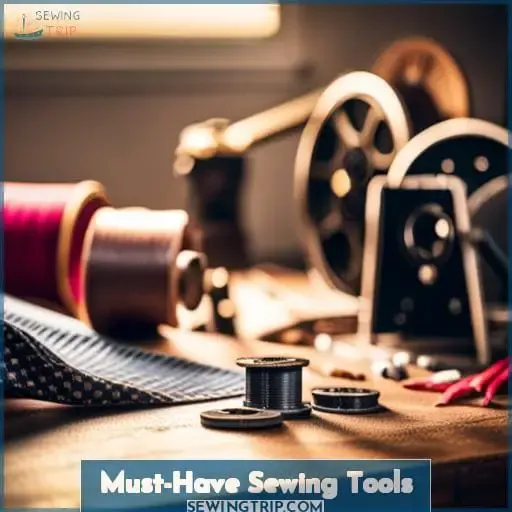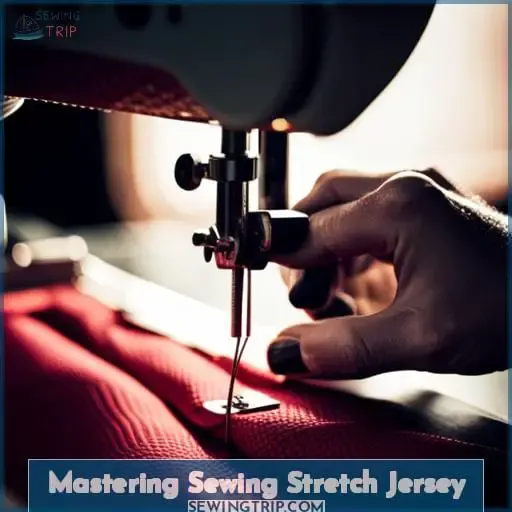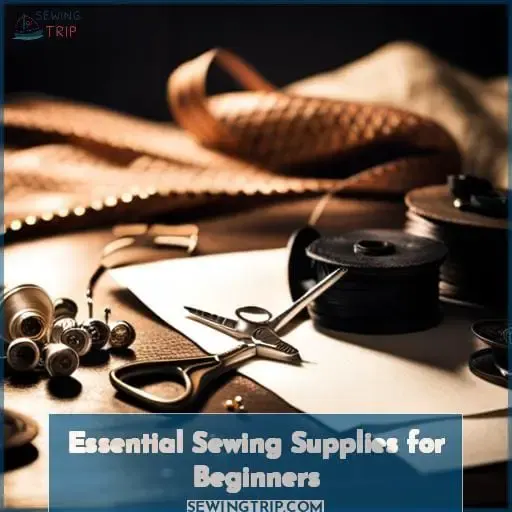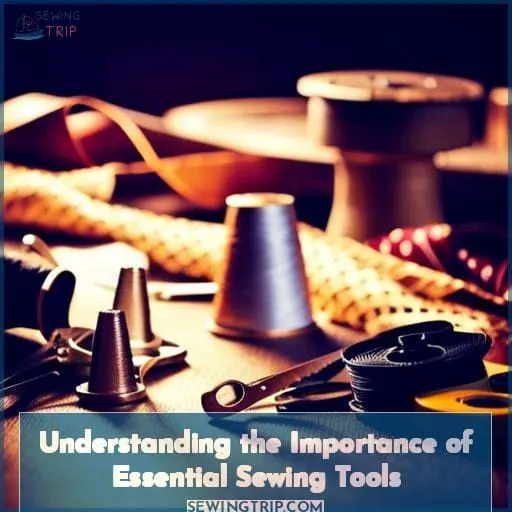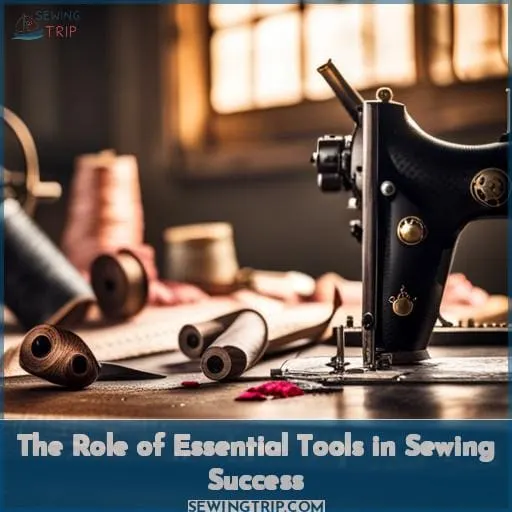This site is supported by our readers. We may earn a commission, at no cost to you, if you purchase through links.
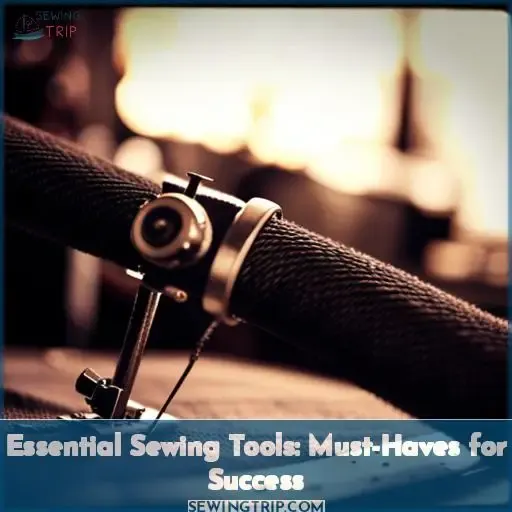 Essential tools are crucial in any sewist’s arsenal. From pincushions brimming with pins, to seam rippers and tape measures, these must-haves for sewing can make or break a project’s outcome. As Confucius once said, The person who chisels their mistakes into milestones is wise.
Essential tools are crucial in any sewist’s arsenal. From pincushions brimming with pins, to seam rippers and tape measures, these must-haves for sewing can make or break a project’s outcome. As Confucius once said, The person who chisels their mistakes into milestones is wise.
Let’s equip ourselves with everything we need to ensure our projects don’t end disastrously.
Table Of Contents
Key Takeaways
- Essential sewing tools are crucial for success.
- Quality tools lead to clean cuts and masterful creations.
- Proper tool selection and care are key to sewing success.
- Organizing tools in clear containers helps keep everything accessible.
Must-Have Sewing Tools
A well-stocked sewing kit is every seamstress’ best friend. You’ll need key tools like pincushions overflowing with pins, sharp sewing shears for accurate cutting, needle threaders that effortlessly glide thread through needle eyes, soft tape measures that conform to curves, bodkins for pulling elastics and drawstrings, and trusty seam rippers for undoing mistakes.
Pincushions Full of Pins
You’ll need your trusted pincushion, chock-full of pins, close by to smoothly sail through your sewing projects. Keep an assortment of straight pins, safety pins, applique pins, and more stored neatly in a tomato, strawberry, heart, cube, or magnetic pin cushion.
Sewing Shears
When slicing delicate silk, only the most jaggedly sharp shears will do. Your shears are precision instruments requiring proper care to remain razor-keen. Never toss them in a drawer where edges grow dull. Store them in protective covers.
Clean lint and residue after each use. Hone them with a whetstone periodically. Let gravity do the cutting; don’t force blades through fabric. With quality shears and careful technique, you’ll achieve clean, flawless cuts and masterly sewing creations.
Needle Threaders
Threading needles can be frustrating, but you’ll breeze through it with a quality needle threader. Wire loop threaders slide the thread right through the eye effortlessly. Metal or plastic, choose one that fits multiple needle sizes.
Insert, catch the thread in the wire loop, pull back out – so simple! Clean lint out regularly for smooth threading every time. For speed, keep one threaded and ready to go. No threader? A twist of paper makes a quick substitute.
Tape Measures
Measure memorable moments marvelously by marking milestones meticulously with measuring marvels.
Never underestimate the necessity of a good tape measure in your sewing toolkit. Whether sewing garments, home decor, or DIY crafts, precision is paramount.
- Mark seam allowances accurately
- Fit patterns precisely to your measurements
- Select the right sewing machine size
Dressmaking demands dedication to detail. Invest in quality measuring tape to seamlessly stitch sensational creations. Love the liberty of a well-fitted look and let proper measuring set your sewing free.
Bodkins
You’ll have an easier time threading elastics and drawstrings through casings with a handy bodkin. Its long, tapered shape slips easily through openings, pulling elastic or cording along. Try a plastic bodkin for thick elastic or a metal bodkin for tightly woven fabric.
No bodkin? Fold a piece of stiff paper into a point to act as one. These affordable tools save frustration when threading drawstrings through hoods or elastic through waistbands.
Seam Rippers
A durable seam ripper will save you hours unpicking stitches as you learn to sew.
- Use the sharp tip for precision. The round end lifts threads.
- Rip in the direction of the original stitching.
- Store safely to avoid dulling the blade.
- Old hotel keycards can work in a pinch.
Seam rippers are among the most essential tools for sewing. Keep one close by to efficiently remove unwanted stitches and start anew.
Mastering Sewing Stretch Jersey
Mastering Sewing with Stretch Jersey
Stretch jersey fabric can seem tricky to work with at first, but there is no need to fear – with the proper tools and techniques, you will be sewing it like a pro in no time! First, familiarize yourself with the properties of this knit fabric.
Then, arm yourself with the appropriate needles and thread so the material glides smoothly through the machine. Next, set your sewing machine to a zigzag stitch and sew seams with plenty of give so the fabric retains its stretch.
If you are still struggling, try pressing the seams open, using an overlock stitch, or even hand-sewing certain parts. With a bit of knowledge and practice, you will find that stretch jersey is a dream fabric to sew.
Part 1: What is Jersey Fabric?
Jersey is a knit fabric that stretches easily and follows your body’s contours. With its soft texture and drapey fabric, it molds to curves. Jersey has a right side and a wrong side. Avoid visible seams on the right side by using a zigzag or overlock stitch.
Pick matching thread colors and lightweight, ballpoint jersey needles. Be prepared to constantly pin to prevent stretching and distortion. Use fabric clips instead of pins. Interface necklines and facings to stabilize. Press with low iron heat using a press cloth.
Part 2: the Best Tools and Equipment for Stretch Jersey Fabric
Because stretch fabric can be tricky, you’d do well to have a serger. Overlockers prevent fraying and create professional seams. Without one, twin needles in a regular machine can mimic serger seams. Choose lightweight ballpoint needles.
Walking feet and tape ensure even feeding. When possible, avoid pins; they can damage knits. For exposed seams, consider lettuce edging or binding to neatly finish them. Experiment with coverstitch and zigzag stitches for creative hems.
Part 3: How to Sew Stretch Jersey on a Standard Sewing Machine
An adjustable needle position is handy when sewing stretch jersey on a standard machine. This allows you to move the needle to the far left, far right, or center as needed for hemming, topstitching, and adding elastic.
Use a new needle and polyester thread to prevent skipped stitches. Engage the machine’s stretch stitch setting if available.
When sewing stretch fabrics like jersey, take advantage of your machine’s features and make adjustments to prevent issues. With the right tools and techniques, you can sew beautiful garments with knit fabrics.
Part 4: Still Stuck? Try These Alternate Methods
You’re stuck on stretchy jersey, don’t despair – try ballpoint needles, tissue paper, a walking foot, or stabilizer to tame that slippery knit fabric. Keep pushing for a workaround with alternate methods. Arm your sewing machine with stretch needles and specialty presser feet to grip knits.
Play with stitch length and thread tension. Weigh down glossy fabric to stabilize it with washaway stabilizer.
Essential Sewing Supplies for Beginners
Gather around, aspiring seamstresses! Before we begin our sewing journey, let’s start with the essential tools. Invest in a quality sewing machine, long and short fabric scissors, pinking shears to finish raw edges, small scissors for quick thread snipping, and a seam ripper for mistakes.
Sewing Machine
Get the Brother XM2701 lightweight machine. You may have heard reviews praise its ease for various sewing projects, though some negatives cite jam issues. But it’s affordable and feature-packed for beginners and experts alike. For sewing machine features, opt for automatic threaders, drop-in bobbins, multiple stitch options like zigzag, and a free arm.
When considering brands, Brother offers reliability and support. Read reviews for real user experiences. Maintain it with regular cleaning and oiling. Choose accessories like feet, needles, and bobbins to expand its abilities.
Fabric Scissors
You need bright pink scissors with knife-edge blades for precisely cutting those fabrics. Select your shears wisely, friends. Sharp blades glide through fabric like butter, leaving clean-cut edges. Mind your cutting techniques too – keep blades sharp, use short snips, never force dull shears.
Clean and oil after each project to prevent rust. Match your fabrics with the right scissors – wovens, knits, delicate laces each have preferences. Invest in quality blades and you’ll have them for life, cutting pattern pieces and seams with surgical precision.
Pinking Shears
Grab some pinking shears to stop the fray on knits and wovens for your next project.
- Clip seams to prevent ravelling.
- Trim and finish raw edges on non-hemmed fabrics.
- Avoid zigzag stitching along curves and corners.
- Create decorative edges with their sawtooth blades.
Forget about finishing seams and edges the old-fashioned way. Pinking shears are the modern solution for preventing fraying fabric. Their zigzag blades seal fabrics while adding flair. Make pinking shears your new best friend for any sewing project.
Small Scissors for Snipping Threads
You’ll want some small scissors for easily snippin’ threads as you sew. As you complete a seam, snip stray threads to prevent tangles and knots. Small scissors allow precise control for clipping close to fabric. Choose sharp micro tip or curved scissors.
Store safely in a sewing kit to prevent nicks. Follow basic sewing safety like directing blades away from fingers.
| Size | Pros | Cons |
|---|---|---|
| Micro tip | Very precise snip | Less control on thick threads |
| Curved tip | Easier access tight spots | Less sturdy |
| 2-3 inches | Versatile use | Not great for detail |
| 4-5 inches | Sturdy, good control | Bulky storage |
| Folding | Compact storage | Can loosen over time |
Keepin’ small sewin’ scissors close by in your project bag or sewing kit allows for quick and safe thread snippin’. Choose a size and shape that fits your hand best for comfort and control. Proper tools make sewin’ faster, easier and safer.
Seam Ripper
Slide a seam ripper into your kit to swiftly remove unwanted stitches. This handy tool makes correcting sewing mistakes a breeze.
- Rip out imperfect seams
- Remove temporary basting stitches
- Undo temporary tacking
A quality seam ripper is essential for any sewing space. Invest in one with a comfortable handle and fine tip for precision picking. Change the blade when it dulls to avoid damaging fabrics. With practice, seam ripping will become quick and easy.
You’ll fix errors and customize projects with ease using this indispensable, economical tool.
Understanding the Importance of Essential Sewing Tools
Now that you’ve assembled your sewing kit with the essential tools, it’s time to understand their importance for your sewing success. Precision tools lead to accuracy and quality craftsmanship in your sewing projects.
Carefully select each tool, from sharp fabric shears to marking chalk, that will enable efficiency in cutting and construction.
Curate a personalized kit of high-performing essentials that suits your unique sewing needs. With the right tools on hand, you gain the power to bring creative visions to life through sewing. Let your kit empower you to achieve the distinctive style and mastery you desire.
The right tools unlock your potential for sewing liberation.
The Role of Essential Tools in Sewing Success
Having the right tools is crucial for mastering your sewing skills and completing projects with confidence. Carefully select high-quality tools that feel comfortable in your hands. Organize supplies in clear containers and maintain sharp blades.
Invest in innovative tools that simplify tasks like cutting and pressing. Quality pins, needles, scissors and sewing machine accessories allow precision and ease. Visit local sewing workshops to test tools before buying. Splurge on shears and rotary cutters for accuracy.
Proper tool selection, care and organization will make projects satisfying rather than frustrating.
Conclusion
You’ve made it this far in your sewing journey, and you’ve got the essential tools to show for it. From the pincushion full of pins to the seam ripper and scissors, you’ve got the right equipment to make any sewing project a success.
Mastering the basics of stretch jersey sewing can be a challenge, so it’s important to know the tools and methods that work best with this fabric. By familiarizing yourself with the right supplies and techniques, you can create beautiful garments that will stand the test of time.
Finally, understanding the importance of essential sewing tools and their role in sewing success is a key factor in becoming a successful sewist. With the right tools, a good plan, and a willingness to learn, you’ll be able to make beautiful garments you can be proud of.

